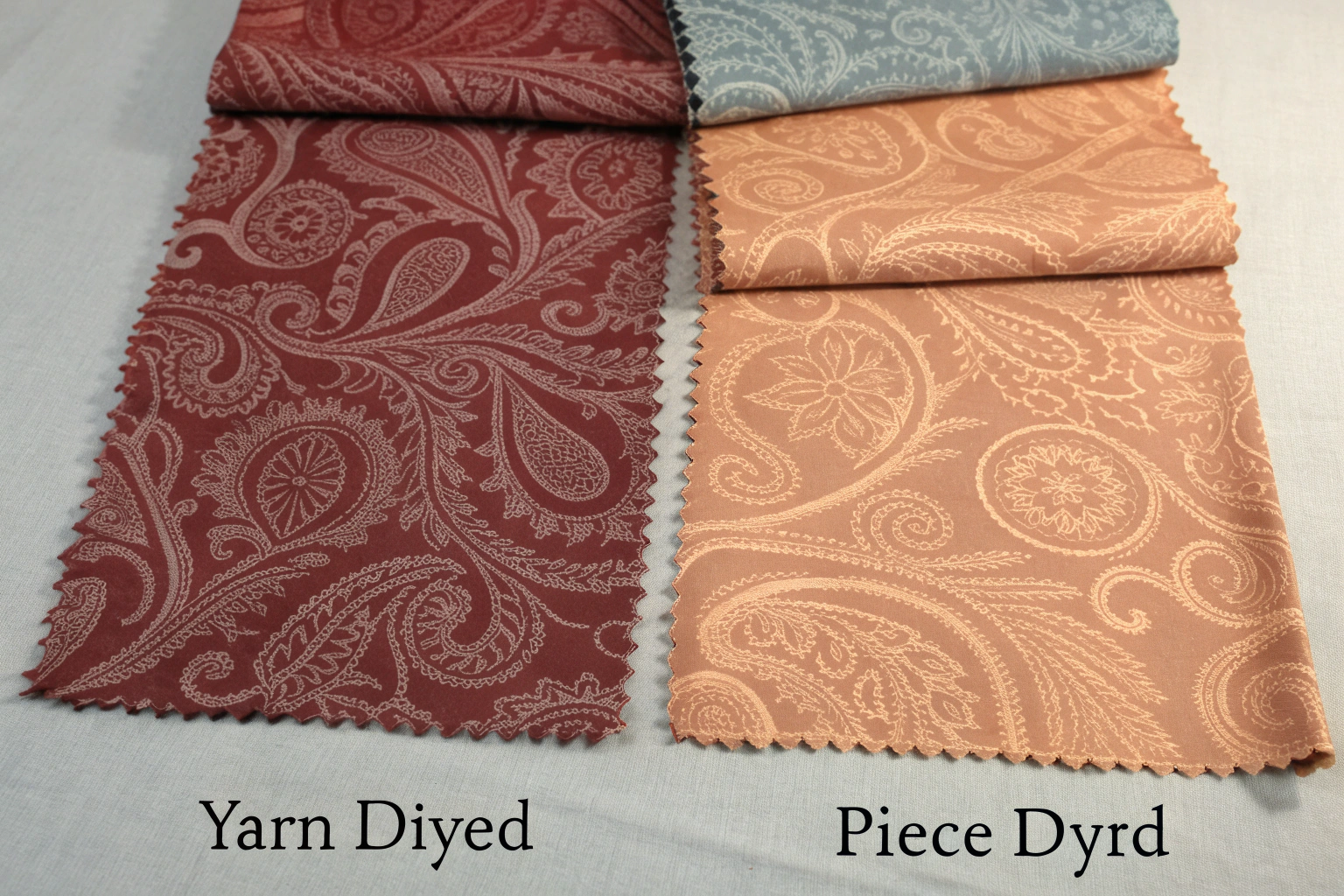As a fabric supplier with over two decades in the textile hub of Keqiao, I often get asked this question by brands and buyers like you. Understanding the core difference between yarn-dyed and piece-dyed fabrics is not just academic—it directly impacts the look, feel, cost, and application of your final product. Many choose the wrong dyeing method and face issues with color consistency or fabric quality later. Let's clear that up right now.
The fundamental difference lies in when the dye is applied. Yarn-dyed fabric involves dyeing the threads before they are woven or knitted together. Piece-dyed fabric is created by weaving first and then dyeing the entire finished "piece" of grey cloth. This simple variation in sequence creates a vast difference in quality characteristics, from color penetration and pattern complexity to hand feel and cost.
This choice is one of the first and most critical you'll make in your sourcing journey. Picking the right method can save you from production headaches, ensure your designs are perfectly executed, and keep your customers happy. Let's dive deeper into what each of these dyeing techniques means for the quality of the fabric you're buying.
What is yarn-dyed fabric?
Yarn-dyed fabric starts with color. The threads, or yarns, are dyed to their specific shades before the weaving process even begins. This method is like creating a painting with pre-colored threads instead of a blank canvas. It is the go-to technique for producing fabrics with intricate, multi-colored patterns such as plaids, stripes, and detailed jacquards. Because the color is locked into the yarn itself, it offers a unique depth and richness.
The defining quality of yarn-dyed fabric is its exceptional color fastness and vibrancy. Since the dye penetrates the individual yarns before the tight weave is constructed, the color is deeply embedded and less prone to fading from washing or friction. Fabrics like chambray, gingham, and madras are classic examples where the pattern is integral to the fabric, not just printed on the surface. This results in a high-end, durable material that maintains its aesthetic appeal over time.
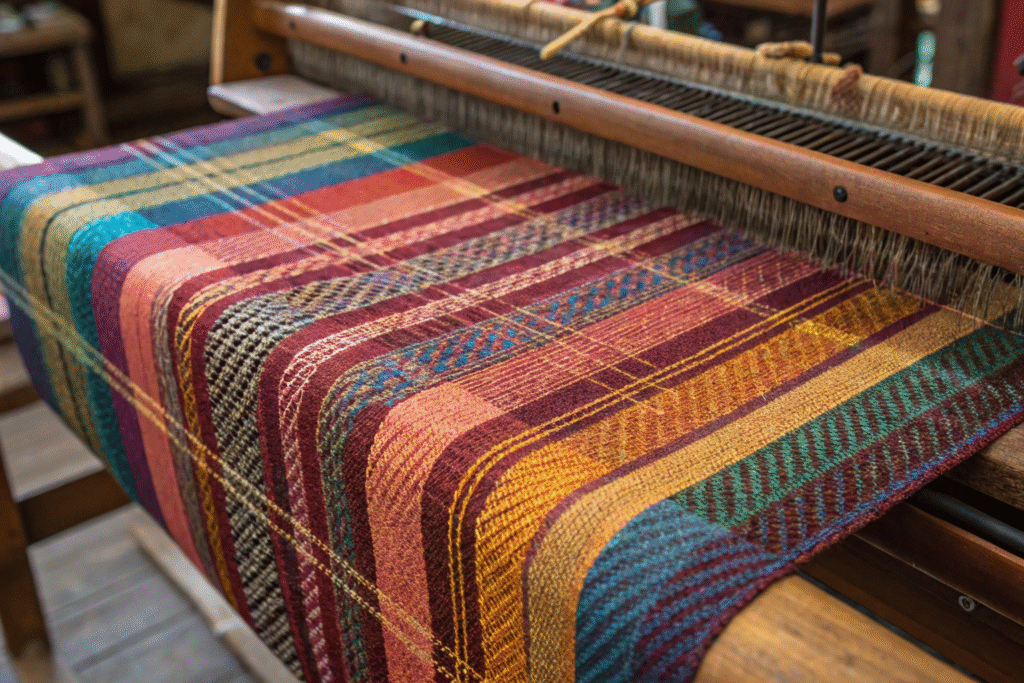
Why choose yarn-dyed for complex patterns?
The primary reason is precision and clarity. When you weave with already-dyed yarns, you can create sharp, well-defined patterns that are part of the fabric's structure. This is technologically superior to printing. For instance, a intricate tartan plaid or a sophisticated jacquard design would be impossible to achieve with the same definition through piece-dyeing or printing. The color boundaries are crisp, and the pattern is reversible in many weaves. Our woven fabric specialists often guide clients towards yarn-dyeing for projects that demand this level of detail and permanence in the design.
How does the yarn-dyeing process affect cost?
The yarn-dyeing process is inherently more complex and expensive. Let's break down the cost drivers:
| Cost Factor | Impact on Final Price |
|---|---|
| Production Time | Longer lead times due to the multi-step process (dye yarns, dry, then weave). |
| Inventory | Higher cost for maintaining large stocks of dyed yarns in various colors. |
| Minimum Order Quantity (MOQ) | Typically higher MOQs to make the production run economically viable. |
| Waste | Potential for more waste if dyed yarns are not fully utilized in weaving. |
Furthermore, the process requires sophisticated yarn dyeing equipment and precise color management to ensure consistency across different yarn batches. This investment in time, technology, and inventory directly translates to a higher price per meter compared to piece-dyed alternatives. However, for the right application, the superior aesthetic and quality justify the cost.
What is piece-dyed fabric?
Piece-dyed fabric is the opposite in sequence. It begins with weaving or knitting the fabric using neutral, un-dyed (grey or greige) yarns. This plain, constructed fabric is then fed through large, industrial dyeing machines where it is colored in one continuous piece. This method is overwhelmingly used for producing solid-color fabrics efficiently and economically. It's the workhorse of the textile industry for basics.
The hallmark of piece-dyed fabric is its cost-effectiveness and efficiency. By postponing the dyeing step until after construction, manufacturers gain immense flexibility. They can produce vast quantities of greige goods and then dye them to match specific color demands quickly. This drastically reduces inventory costs and allows for smaller color-specific MOQs. The process is ideal for achieving uniform, solid shades across large fabric rolls, making it perfect for basic knitwear and many everyday garments.
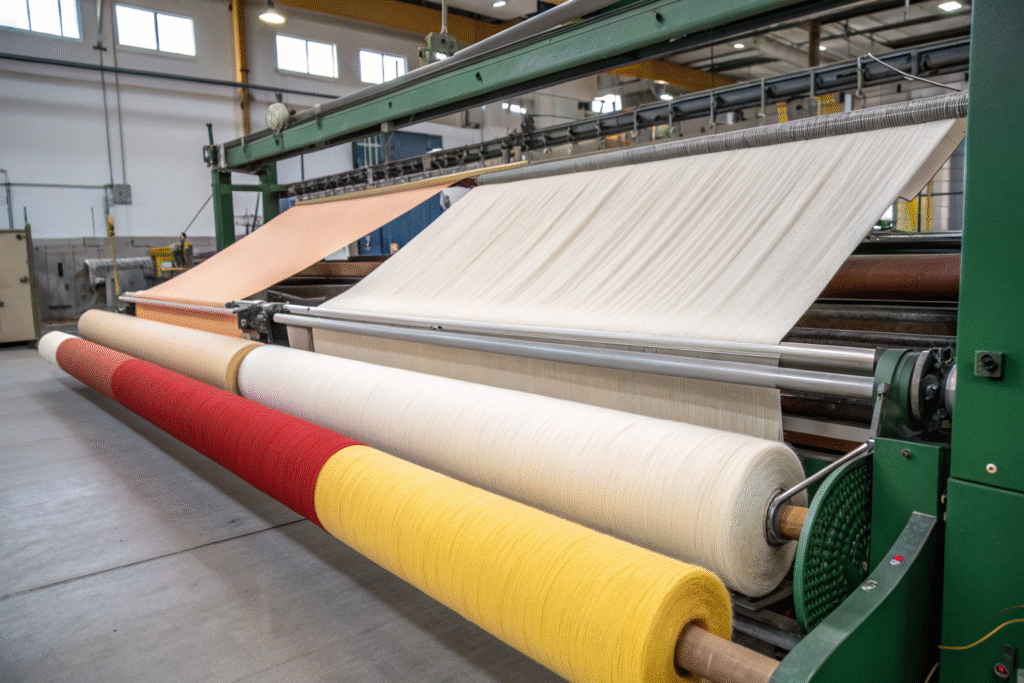
Is piece-dyed fabric less colorfast?
Not necessarily. The colorfastness of piece-dyed fabric depends heavily on the fiber content and the quality of the dyeing process. While the dye application is to the finished fabric, modern piece dyeing techniques like jet dyeing ensure good penetration. For natural fibers like cotton, the results can be excellent. However, on very thick fabrics or tight weaves, there is a theoretical risk of less penetration to the core compared to yarn-dyeing, but this is managed professionally in quality-controlled production.
What are the main advantages of piece-dyeing?
The advantages are primarily operational and economic, which ultimately benefit the buyer.
- Cost-Efficiency: It is significantly cheaper than yarn-dyeing. There are no costs for storing pre-dyed yarns, and the process itself is faster and less labor-intensive.
- Flexibility and Speed: Brands can decide on colors much closer to the season. A factory can hold greige fabric and dye it to order, enabling a faster response to fashion trends. This aligns with the agile supply chain we've built at Fumao, offering quick bulk delivery.
- Color Consistency: Dyeing a whole batch of fabric at once in a single machine ensures a very consistent shade across the entire order, which can sometimes be a challenge with multiple batches of dyed yarns.
How to choose between yarn-dyed and piece-dyed?
The choice boils down to your design goals, budget, and quality requirements. It's a strategic decision that impacts your product's final look, feel, and price point. There is no universally "better" option—only the right option for your specific project. As your partner, we help you navigate this choice based on two decades of experience supplying both types to global brands.
Let's simplify the decision-making process with a clear framework. Ask yourself these questions: Does my design have multiple colors in a woven pattern (like a plaid or stripe)? Is a vintage, heirloom, or high-end aesthetic a key part of my brand identity? If the answer is yes, then yarn-dyed is your only viable path. Are you producing a solid-color garment where cost and speed-to-market are critical? Then piece-dyed is the efficient and smart choice.
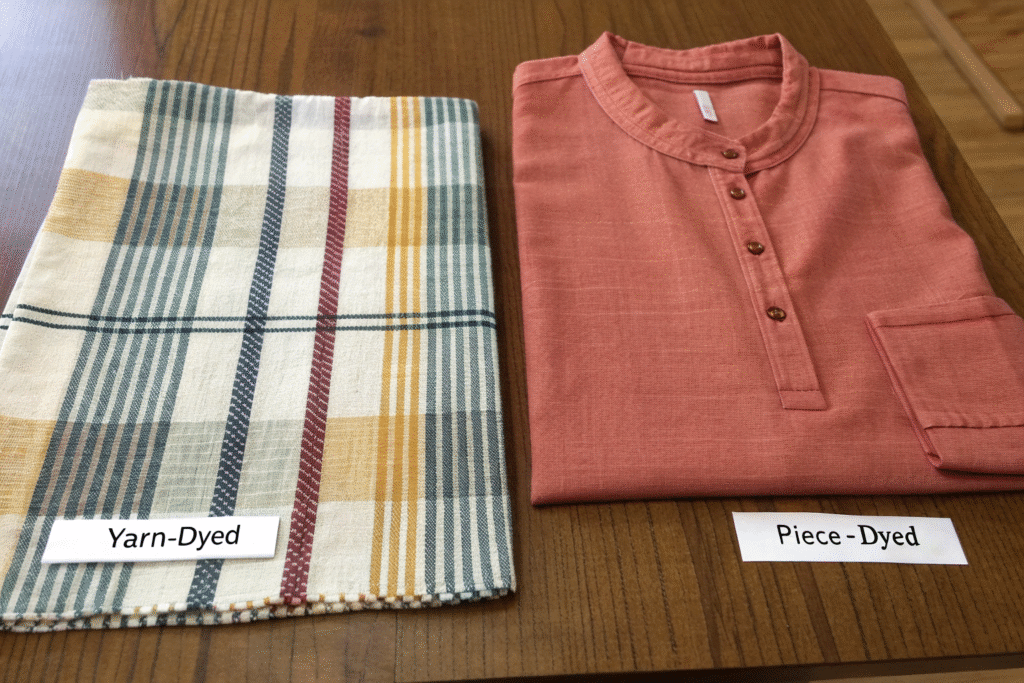
When is yarn-dyed fabric the superior choice?
Yarn-dyed fabric is superior when the design is the hero. Choose it for:
- Patterned Fabrics: Any fabric where the pattern is created by the weave itself: stripes, checks, plaids, jacquards, and damasks.
- High-End Quality: When you are aiming for a premium product with excellent color retention and a perception of higher quality.
- Color Richness: When you desire a multi-colored fabric with a depth of color that printed fabrics cannot replicate. Our shirting fabrics often utilize this for luxury lines.
When does piece-dyed fabric make more sense?
Piece-dyed fabric is the pragmatic choice for:
- Solid Colors: The vast majority of solid-color garments in the world are piece-dyed. It is the standard for efficiency.
- Budget-Conscious Projects: When you need to manage costs effectively without sacrificing basic quality, piece-dyeing offers the best value.
- Agile Sourcing: If you need to test the market with a style and then react quickly with color variations, holding greige goods for later dyeing is the best strategy. This supports a small-batch customization model.
What about quality in production and sourcing?
Beyond the initial choice, ensuring consistent quality in production and a smooth sourcing experience is paramount. The dyeing method influences lead times, quality control checks, and logistics. At Fumao, our integrated control from dyeing to weaving to inspection is what gives our partners, especially those in the U.S., peace of mind regarding timeliness and tariff costs.
For yarn-dyed fabrics, quality control starts at the yarn level. We check color consistency between yarn batches before weaving even begins. For piece-dyed, the focus is on ensuring even dye uptake and checking for defects after the dyeing process. Our CNAS-certified lab tests both for colorfastness to washing, rubbing, and light, ensuring they meet international standards like SGS, which is crucial for gaining the trust of large buyers.
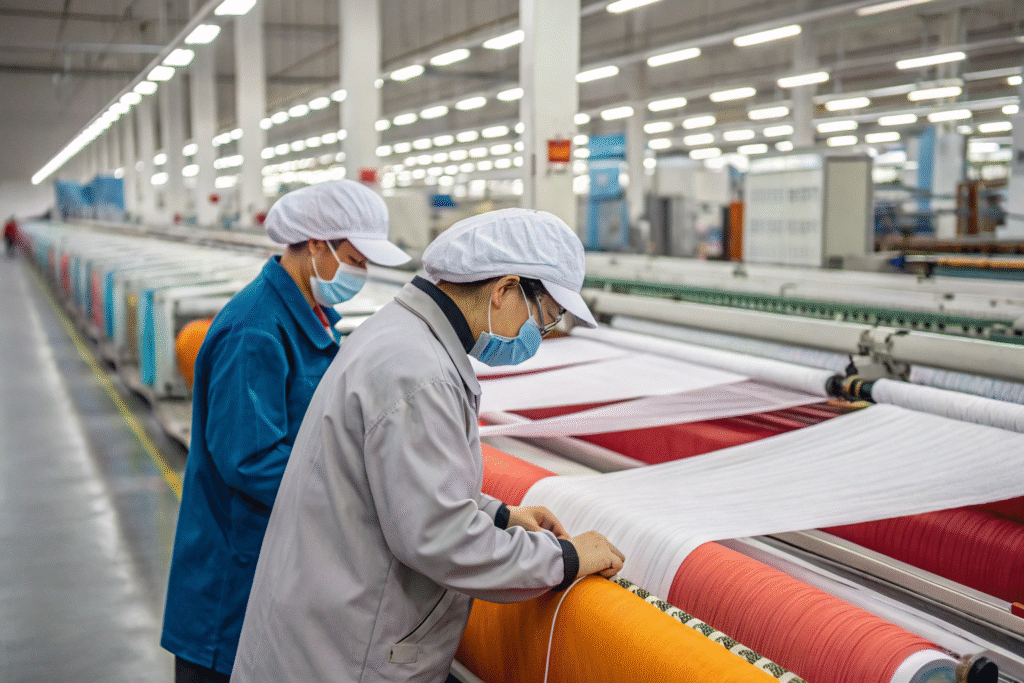
How can you verify fabric quality and compliance?
Always partner with a supplier that provides transparent and verifiable data.
- Request Test Reports: Ask for specific test reports for colorfastness and composition. We provide QR codes on our shipments for real-time access to this data.
- Ask About Certifications: For eco-friendly claims, verify certifications like GRS for recycled polyester or OCS for organic cotton. The dyeing process must also comply with eco-standards like OEKO-TEX.
- Source Directly: Sourcing directly from a manufacturer like us, with in-house dyeing partnerships, removes layers of communication and reduces the risk of errors. We manage the entire process, ensuring the final quality matches your expectations.
What are the logistics benefits of a direct supplier?
Working with a direct, integrated supplier like Fumao mitigates many pain points voiced by our American clients.
- Efficient Pricing: Our control over the supply chain allows for transparent and competitive pricing, without hidden markups.
- Timeliness Control: With our owned and cooperative factories, we control the production schedule, enabling us to meet the 48-hour sampling and quick bulk delivery we promise.
- Tariff Advantage: As a China-based supplier, we expertly handle packaging and customs clearance. Our fabrics are not affected by US tariffs, providing you with significant cost security and predictability that suppliers in other regions cannot guarantee.
Conclusion
Choosing between yarn-dyed and piece-dyed fabric fundamentally shapes your product's identity, cost, and market positioning. Yarn-dyed offers unparalleled pattern integrity and a premium hand for designs that demand it, while piece-dyed provides the efficiency, cost savings, and flexibility required for solid-color basics and fast-fashion cycles. There is no one-size-fits-all answer, but a strategic decision based on your specific needs. Understanding this core difference empowers you to make informed sourcing choices, avoid costly mistakes, and create collections that truly resonate with your customers.
Ready to bring your next fabric concept to life with the right dyeing technique? Let's collaborate. Our team, led by our expert Business Director Elaine, is ready to guide you through every step—from selecting the perfect base fabric to managing the complex logistics of getting your order to your doorstep. For a partnership that combines quality, innovation, and reliability, contact Elaine directly at elaine@fumaoclothing.com to discuss your clothing order production needs.

